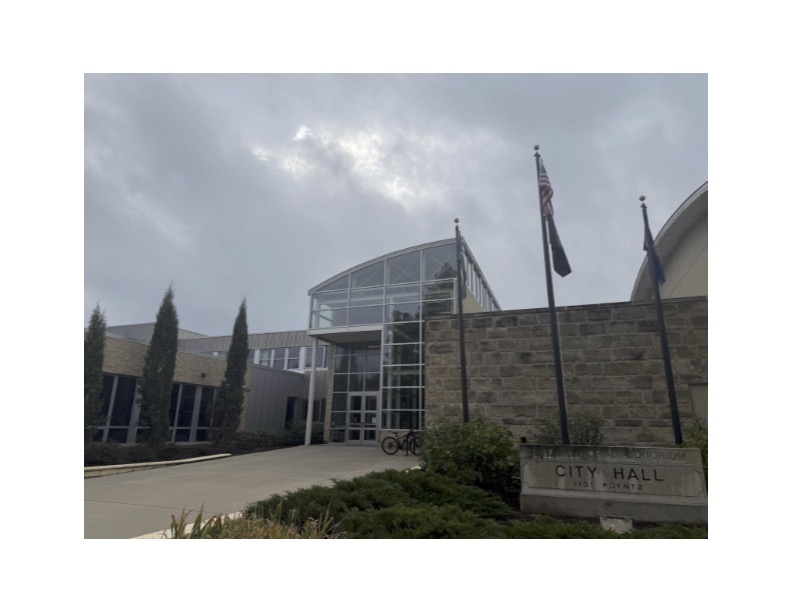
Max Ashford
The Manhattan City Hall houses City of Manhattan offices and organizations. City Council meetings are held in this building.
At a community forum on Oct. 5, candidates discussed issues that directly affect students of Kansas State. With elections coming up for three open seats on Nov. 4, the potential long-term implications of the city’s development priorities are a concern for all city residents. These include a lack of parking and ongoing construction affecting traffic flow in Manhattan.
As election season nears in Manhattan, city commission candidates are offering differing visions for the community’s growth — from how to fix parking frustrations to what the future holds for Aggieville and downtown development.
Parking remains one of Manhattan’s most debated and discussed issues, particularly in Aggieville and downtown areas. While most candidates agree that parking problems exist, they differ on how to manage or redesign it to better serve the city’s residents and visitors.
Candidate Jamie Minton said parking is often “a perception problem” rather than a shortage. She pointed to more than 3,500 spaces available downtown, noting that communication and technology are key.
“When the ParkMobile app was first introduced, some people had struggles,” Minton said. “We need to be cognizant that people need help with technology.”
Fellow candidate Scott Seel said the debate reflects deeper issues with how the city plans to alter transportation paths. He supports encouraging public transportation and walkable streets instead of adding more lots.
“The main difference is providing adequate parking and how we can decrease emphasis on cars,” Seel said.
Peter Oppelt, who currently serves on the commission, agreed that cities have historically been too vehicle focused and should explore other transportation options to optimize energy.
“Parking is always going to be a challenge,” Oppelt said. “We need to move from being car-centric to making travel more walking or bicycle-centered, while still keeping accessibility in mind.”
Each candidate also emphasized different visions for Manhattan’s downtown area. Seel, who serves on the downtown committee, said he hopes to bring residential living back to the core of the city.
“We want people living downtown again on walkable streets with places to play,” he said.
Minton said her long-term goal is to extend downtown beyond its current boundaries.
“You can’t look at downtown in a short-term way like 10 years, it’s more like 30 or 40,” she said. “We want to expand the heart of the community, maybe even across Tuttle Creek Boulevard.”
Oppelt pointed to a major downtown project set to break ground soon, saying it will help redefine the area.
“Once it’s done, we’ll take a look and see how things operate,” Oppelt said. “The dining platforms were controversial at first, but people have learned to love them.”
All three candidates acknowledged resident frustrations, but said improvements require patience. Seel said that community members must decide what matters more to them: smooth roads or roads free of construction.
“People can complain about potholes or construction — not both,” Seel said.
Perhaps no topic drew more passion from the crowd than the Aggieville talking point. All three candidates said the district should serve multiple roles, but they slightly differ on what that balance should look like.
Seel wants to maintain Aggieville’s lively nightlife while bringing in more daytime activity through new shops and housing.
“I don’t want the nightlife to go away … I want people to enjoy it all day, all season,” Seel said.
Minton echoed that mix, emphasizing Aggieville’s importance to K-State culture.
“Aggieville serves multiple uses — you can grab lunch there and not be out crazy late for the party scene,” she said. “It’s also a recruiting opportunity for incoming students.”
Oppelt sees the split between downtown and Aggieville as beneficial for students and the permanent citizens alike.
“Aggieville can be a mix,” he said. “The rowdy crowd can be rowdy without infringing on the people who want to chill.”
Because of the impact these appointed officials may have on student life, he urged students to get involved in the election.
With Manhattan’s growth showing no signs of slowing, voters on Nov. 4 will decide how the city should balance its small-town traditions with the proposed modern developments.
While the candidates have different opinions on key issues like parking, downtown redevelopment and the future of Aggieville, each candidate is passionate about Manhattan’s next chapter.
Poll locations vary by precinct, and candidates can be researched on the Riley County website.